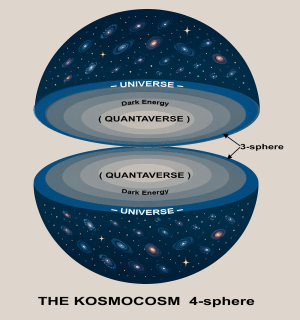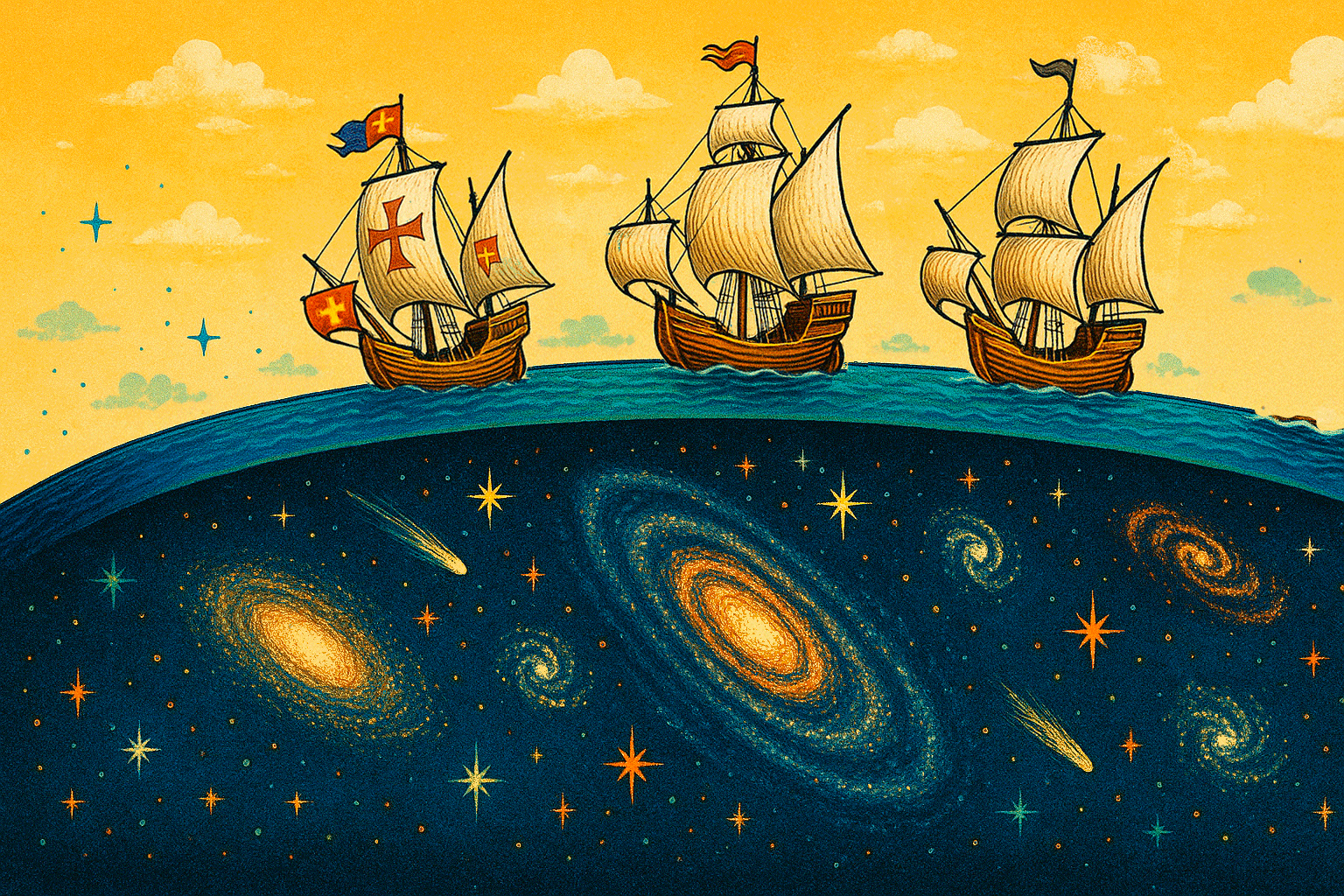Long, long ago, in a galaxy far, far away, before the Earth knew ships, before the heavens were mapped, a star was born. It blazed into being with a brilliance so pure, so white, it seemed stitched from the fabric of creation itself. Its light surged outward in every direction, untouched by time.
Meanwhile, on a blue planet tucked within a spiral arm of the Milky Way, a young adventurer named Columbia — “Just Columbia,” she insisted — stood before the queen.
She bowed low, her eyes reflecting the fire of her dream.
“I beg you to believe,” she said, “that our universe is not flat, but curved, an immense sphere of space. I wish to sail it, to circumnavigate the cosmos itself.”
The queen narrowed her gaze. “And why bring this madness to me?”
“Because I need ships. Strong ones. I need crew, provisions, and faith. I need someone who believes that the edge of what we know is not the end of what is.”
The queen tilted her head, amused. “Once, I gave wings to Daedalus and his boy, Icarus. They promised escape. The son flew too high. The wax melted. All I got was a ruined investment.”
Columbia did not flinch. “I do not promise wings. I promise a path. I will sail to that golden star in the heavens and return with its gold for your crown.”
The queen smirked. “Then I wager two pies you shall not return before the universe ends.”
And with that, Columbia set sail, her ships not on seas, but on starlight and dreams.
We don’t know where Columbia is now. Her voyage pierces depths we can only imagine. But we do know this: the star she sought is not gold. Its color lies to us. Or rather, the truth bends along its journey.
More on that soon.
Have We Misread the Shape of the Universe?
For over a century, cosmology has walked the line of Euclid. We imagined space as a flat, endless plane, a smooth, silent scaffold on which galaxies drift and light behaves in a predictable manner. This assumption made the equations easier. It felt intuitive. It echoed the instincts of mapmakers and mathematicians alike.
But something is shifting. Something profound.
Two cosmic clocks, each pristine and each trusted, now tick to different tempos.
One is ancient: the faint afterglow of the Big Bang, stretched into microwaves. Captured by the Planck satellite, this light tells us the universe is expanding at 67 kilometers per second per megaparsec — that’s fast!
The other is local: the brilliant deaths of stars, supernovae exploding in nearby galaxies. These luminous flares, first charted by astronomer Edwin Hubble a century ago, suggest a faster pace, closer to 73 kilometers per second per megaparsec.
Both clocks read the redshift in light. As galaxies recede, their emitted light stretches, its color sliding from blue to red, like a train whistle lowering as it rushes away.
And that golden star Columbia saw? It wasn’t gold. It was white. Its light, stretched across the arc of the cosmos, had shifted toward red, a cosmic illusion born of motion and time.
This tension between expansion rates, known as the “Hubble tension,” has not abated. It has sharpened. New instruments have only deepened the divide. It implies that the universe is expanding at an ever-faster rate. And so, a quiet panic has set in.
Have we misunderstood something fundamental? Not about the stars themselves, but about the shape of the stage on which they shine?
What If the Universe Is a Sphere?
While we chase exotic fixes — dark energy that comes and goes, particles we haven’t yet seen — one quiet assumption has remained immune.
That space is flat.
But what if it’s not?
What if, instead of an infinite plane, the cosmos is a curve: graceful, finite, whole? Not a saddle. Not a sheet. A sphere. Ancient and elegant.
This is not mere fantasy. In 2020, cosmologists Eleonora Di Valentino, Alessandro Melchiorri, and Joseph Silk published a provocative finding in Nature Astronomy: the Planck data may favor a closed universe. Not open. Not flat. But closed, like the surface of a globe, and in three spatial dimensions. A 3-sphere.
They called it “a possible crisis for cosmology.” … Few believed them.
But perhaps it is a key.
How to Imagine a 3-Sphere

Think back to an Earth before it was understood to be round. Sailors believed they journeyed across a flat world. Columbus believed otherwise, and though it was Magellan’s crew who proved the loop, the vision belonged to Columbia’s kind.
Now, add a dimension. Imagine not just a round Earth, but a round universe. A 3-sphere: the surface of a four-dimensional sphere I call the Kosmocosm. This 4-sphere encompasses the 3-sphere universe and the core dark energy, which I refer to as the Quantaverse. We live not in its core, nor outside it, but upon its boundary — the Universe.
Picture the universe as a vast, cosmic ocean. It does not float in space, but forms the skin of a four-dimensional balloon. Galaxies drift like jellyfish, and light is the current that carries their memory. It’s all the ordinary visual matter, all the dark matter, it’s spacetime and gravity.
We cannot see the fourth dimension, but we can feel its consequences. In this curved geometry, if you travel far enough, you could, someday, arrive back where you began. Not by turning, but by continuing forward along the arc of space itself.
And how far is that? About 86.7 billion lightyears: the circumference of a 3-sphere whose radius is the universe’s age, multiplied by 2π. That is why the queen felt safe with her bet.
No sailor, no matter how brave, can cross that sea in a single cosmic breath.
When Light Bends, So Does Truth
In a flat cosmos, light travels in straight lines. But on a sphere, the paths of photons curve gently along the surface. The deeper they travel, the more the geometry warps their journey.
This distortion is quiet, but it accumulates. Like trying to map the Earth onto a flat sheet, the farther you go, the more wrong the map becomes. Greenland appears vast, Africa diminished. It is called a projection error.
Now apply that principle to the stars.
When we observe ancient supernovae, we see light that departed when the universe, our 3-sphere shell, was more tightly curved, wrapped in a smaller 4-sphere. But our instruments interpret that light using today’s geometry: wide, loose, flat.
The result is a built-in illusion. Distant galaxies seem farther than they are. Their light, having curved across a shrinking sphere, appears redder, dimmer, and delayed.
We read it as acceleration.
But perhaps it is geometry.

Recalibrating the Cosmos
If the universe is a sphere, our measuring sticks are flawed. We have been stretching lines across a curved surface, forcing harmony where none exists.
This could explain the Hubble tension, not with new forces, but with older truths. Light from ancient sources was born in a younger universe: smaller, tighter, more curved. Applying flat-space equations introduces systemic distortion.
What seems like a contradiction becomes concord when viewed through the right lens. The calculations through the right lens remove this assumed Hubble tension. The math proves it.
Einstein’s equations permit this. General relativity sings of curvature. It never required a flat cosmos. We imposed that simplicity, but nature is under no obligation to be simple.
Planck satellite’s data whispers of closure. If confirmed, it would mean that the cosmos curves back upon itself: not infinitely, but meaningfully and elegantly.
Beyond the Curve: Toward the Quantasphere
This geometric revelation does not stand alone. It may be a doorway.
Beneath the curvature lies something deeper still: a quantum architecture that informs the shape we see, the paths photons take, and the rhythm of expansion. It may govern not just light and gravity, but conscious awareness itself.
This is the Quantasphere: a foundational weave of quantum snapshots, spacetime harmonics, and encoded memory. A silent archive beneath the unfolding present. Today, it is called dark energy.
It may be the true Theory of Everything.
But that is a story for another time.
One Final Reflection
Is Columbia still sailing? Somewhere beyond the Orion Arm, tracing the golden arc of a star that shimmered before Earth ever dreamed of empires?
We cannot say.
But we can ask the question.
What if the universe isn’t flat?
And what if that changes everything?
⸻
Footnote: I have several, yet-to-be-published, serious scientific papers that inspired this story. Stay tuned for more stories from the edge of space, time, and thought.


Please leave a comment …
Add a comment